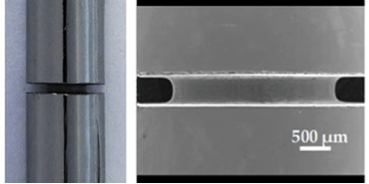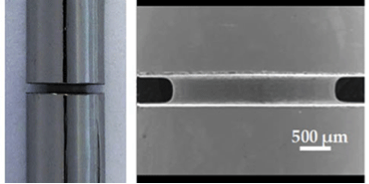Strength Training
Pulling and rolling are common ways to “work” a metal and make it stronger. But the same treatment doesn’t help metallic glasses—uncommonly strong, noncorrosive metal alloys that have promising applications as biomaterials and in electronics are already being used to make knives that never dull. Instead, these materials weaken—and even break—when over-stretched. In Physical Review Letters, Zhi Tao Wang at the National University of Singapore and colleagues now report they have found certain conditions under which pulling on a metallic glass may actually make it stronger.
As grown, metallic glasses are more elastic and stronger than conventional metals because they have an amorphous (as opposed to crystalline) structure. Researchers have assumed that stretching a metallic glass beyond its elastic limit has two effects: atoms diffuse more rapidly and low-density “bands” form throughout the material. Because the extra space in the bands tends to accumulate faster than the atoms can diffuse to fill it, the atoms slide easily, and the material is more susceptible to breaking.
Wang et al. used a mechanical model to show that distributing a stretching force along more than one direction can favor the diffusion process over the accumulation of extra space. To test the idea, they prepared a long rod of a zirconium-copper-nickel-aluminum metallic glass and measured how much it stretched under a tensile force. They then carved out an hourglass-shaped waist in the same rod, so that a component of the force would be perpendicular to the rod’s length. The carved rod withstood an larger force, and strengthened with each stretching cycle, suggesting that under the right conditions, a metallic glass can harden under stress instead of soften. – Jessica Thomas





